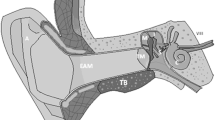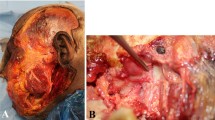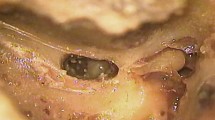Abstract
The discomallear ligament (DML) runs through a narrow space of bony petrotympanic fissure, which joins the articular disc of the temporomandibular joint (TMJ) and the malleus in the tympanic cavity. Previous report suggest that an anatomical feature gives rise to TMJ pain and dysfunction. Recently, the movement of the malleus caused by hypertension on the discomallear ligament is important to the function of the TMJ. The purpose of this study is to define its morphological features using the cone beam CT (CBCT) and anatomical dissection of Japanese cadavers. Petrotympanic fissure and DML were observed in 14 cadavers (eight males and six females). It is revealed that a wide tunnel-like structure was found on CBCT images in the middle region of the petrotympanic fissure to the malleus in the tympanic cavity consisting of mainly three types: a wide tunnel-shaped structure (29.2%, 7/24, type 1), a tunnel-shaped structure widely open in the entrance of the petrotympanic fissure to the mandibular fossa and gradually thinning out in the tympanic cavity (20.8%, 5/24, type 2), and a tunnel-shaped structure widely open in the entrance of the mandibular fossa, middle region with flat-shaped tunnel structure and narrow exit in the tympanic cavity (41.7%, 10/24, type 3). These structures between the entrance of the petrotympanic fissure and the exit at the tympanic cavity are important to define the limited movement of the malleus. Therefore, morphological feature of the ligaments in malleus may relate to TMJ pain, dysfunction and hearing function.


Similar content being viewed by others
References
Abe S, Ouchi Y, Ide Y, Yonezu H (1997) Perspectives on the role of the lateral pterygoid muscle and the sphenomandibular ligament in temporomandibular joint function. Cranio 15:203–207
Cesarani A, Tombolini A, Fagnai E, Domenech Mateu JM (1991) The anterior ligament of the humanmalleus. Acta Anat 142:313–316
Couly G, Hureau J (1976) Les relations otoméniscales de L`articulation temporo-mandibulaire dunoveau-né. Arch Ant 59:143–150
Kim HJ, Jung HS, Kwak HH, Shim KS, Hu KS, Park HD, Park HW, Chung IH (2004) The discomallear ligament and the anterior ligament of malleus: an anatomic study in human adults and fetuses. Surg Radiol Anat 26:39–45
Lacout A, Marsot-Dupuch K, Smoker WR, Lasjaunias P (2005) Foramen tympanicum, or foramen of Huschke: pathologic cases and anatomic CT study. AJNR Am J Neuroradiol 26:1317–1323
Loughner BA, Larkin LH, Mahan PE (1989) Discomalleolar and anterior malleolar ligaments: possible causes of middle ear damage during temporomandibular joint surgery. Oral Surg Oral Med Oral Pathol 68:14–22
Ogutcen-Toller M (1995) The morphogenesis of the human discomalleolar and sphenomandibular ligaments. J Craniomaxillofac Surg 23:42–46
Pinto OF (1962) A new structure related to the temporomandibular joint and middle ear. J Prosthet Dent 12:95–103
Rodríguez-Vázquez JF, Mérida-Velasco JR, Mérida-Velasco JA, Jimenez-Collado J (1998) Anatomical considerations on the discomalleolar ligament. J Anat 192:617–621
Sperber GH (2001) Craniofacial development. BC Decker Inc, Ontario, pp 184–189
Toledo-Filho JL, Zorzetto NL, Navarro JA (1985) Structures and relationships of the anterior malleus ligament. Anat Anz 158:13–22
Acknowledgments
We wish to thank Drs. Shunji Yoshida and Yoko Miwa (Department of Anatomy, Nippon Dental University) for their helpful encouragement to our study.
Author information
Authors and Affiliations
Corresponding author
Rights and permissions
About this article
Cite this article
Sato, I., Arai, H., Asaumi, R. et al. Classifications of tunnel-like structure of human petrotympanic fissure by cone beam CT. Surg Radiol Anat 30, 323–326 (2008). https://doi.org/10.1007/s00276-008-0327-4
Received:
Accepted:
Published:
Issue Date:
DOI: https://doi.org/10.1007/s00276-008-0327-4




